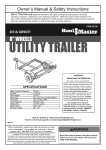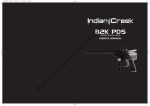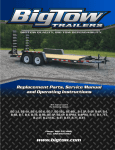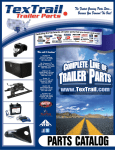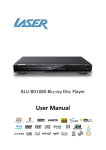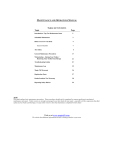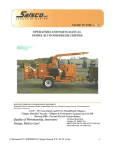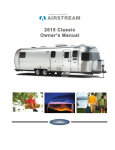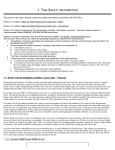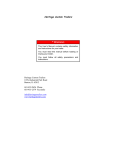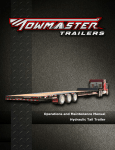Download 61997-Intrst Man Cvr_Layout 1
Transcript
Enclosed Trailers INTERSTATE GROUP, L.L.C. CORPORATE OFFICE 3800 Airport Road Nampa, ID 83687 (208) 442-7600 MANUFACTURING PLANTS 224 Carnation Drive 4400 Interstate Way Nampa, ID 83687 Kingman, AZ 86401 (208) 466-6777 (928) 681-5300 3601 Dave Ward Drive Conway, AR 72034 (501) 505-2000 www.interstatecargo.com THANK YOU FOR CHOOSING Interstate! Congratulations on your purchase of the finest enclosed trailer on the market today! Interstate builds a wide selection of durable work and play trailers. Our name is synonymous with quality and affordability. We are confident this trailer will provide solid, reliable, and safe service throughout your many years of ownership. Please complete the form below. This information will be needed when contacting us or your local Interstate dealer concerning parts, service, warranty, or other questions you may have. Date Purchased Serial # Model # Dealer Name Address City State Zip Code Phone # Thank you for buying Interstate! Please take a few minutes to fill out your warranty card. i TABLE OF CONTENTS & YOUR INTERSTATE OWNER’S MANUAL Trailer Information ....................................... i Limited Warranty . . . . . . . . . . . . . . . . . . . . . . . . . . . . . . . . . . . . . . . . 1 Trailer Decals and Warning Labels . . . . . . . . . . . . . . . . . . . . . . . . . . 3 ß Pre-Trip Check Points ß 102" Wides ß Wheel Lugs ß Ramp Door Spring Tow Vehicle Wiring . . . . . . . . . . . . . . . . . . . . . . . . . . . . . . . . . . . . . . 6 7-Way Plug Wiring Diagram and 6-Way Plug Conversion . . . . . . . . 7 Checking and Maintaining Your Trailer . . . . . . . . . . . . . . . . . . . . . . . 9 ß Initial Trip Checklist ß Axles / Hubs / Brakes ß Wheels ß Ball Coupler Hitches ß Hitch Balls and Safety Chains ß Gooseneck and Fifth Wheel Trailers ß Breakaway Switch and Battery ß Jacks ß Trailer Exterior and Interior ß Doors / Windows / Vents ß Routine Maintenance Checklist Load Distribution . . . . . . . . . . . . . . . . . . . . . . . . . . . . . . . . . . . . . . . 20 Reporting Safety Defects . . . . . . . . . . . . . . . . . . . . . . . . . . . . . . . . . 21 Maintenance Record . . . . . . . . . . . . . . . . . . . . . . . . . . . . . . . . . . . . 22 Our Commitment to You . . . . . . . . . . . . . . . . . . . . . . . . . . . . . . . . . 24 ii LIMITED WARRANTY INTERSTATE GROUP, L.L.C., hereinafter referred to as INTERSTATE, warrants to the original owner that: your INTERSTATE trailer will be free from defects in materials and workmanship for the following periods: Pro-Series – Three years from the date of purchase, lifetime roof warranty. LoadRunner – One year from the date of purchase, five-year roof warranty. Victory – Six months from the date of purchase, one-year roof warranty. All warranties are, except as herein limited, from the date of purchase provided all stated conditions and exclusions are met and satisfied. The obligation of this warranty shall be limited to repairing or replacing any part or parts which, in the opinion of INTERSTATE, shall be proved defective in materials or workmanship under normal use and service during the warranty period commencing with the date of purchase subject to the conditions and exclusions listed below: WARRANTY VALIDATION A warranty registration card is included with the dealer paperwork. The dealer must fill out and mail the certificate to Interstate within (10) days after making delivery of the trailer. This purchaser record is required by law. Failure to complete and submit the registration card will automatically void the Warranty. HOW TO OBTAIN WARRANTY SERVICE F 1. All Warranty requests must be presented to INTERSTATE with the proper 2. 3. 4. arrangements made and approved by INTERSTATE prior to any work being done. All Warranty repairs must be performed at INTERSTATE in Nampa, ID, Kingman, AZ, or Conway, AR unless prior written approval is obtained from INTERSTATE before said repairs begin. In certain cases INTERSTATE may, at its option, elect to have warranty work performed in the field by a qualified repair shop. INTERSTATE will not be obligated in any way to pay for repairs made without its specific advance approval. Any repairs performed without its advance approval, INTERSTATE may pay at its sole option, in an amount not to exceed what the parts and labor cost would have been if INTERSTATE had performed the repair. The parts and labor cost to perform a repair will be limited to the customer’s original purchase price from INTERSTATE of those items and the installation charges from INTERSTATE for those items. Any premium charges for overtime labor, service calls, towing or transportation are the sole responsibility of the customer and will not be paid for by INTERSTATE. WHAT IS NOT COVERED 1. Axles are covered by the manufacturer's warranty as follows: Torsion Axles • Two (2) Years for Workmanship such as defects in welds. • One (1) Year on moving parts such as Hubs, Brakes, Bearings. • Five (5) Years on the Torflex beam only. Spring Axles • Two (2) Years for Workmanship such as defects in welds. • One (1) Year on the moving parts such as Hubs, Brakes, Bearings. 1 LIMITED WARRANTY 2. Tires are covered by the tire manufacturer’s warranty. Present all claims for tire adjustments to a tire dealer who handles the brand in question. 3. Food service and beverage equipment, air conditioners, water heaters, generators and refrigerators are all covered by their respective manufacturer’s warranty. Warranty validation and claims are to be handled directly with the particular manufacturer. 4. Electrical components, lights, jacks, (manual or hydraulic), plumbing, fiberglass parts, window, doors, sealants, seals, locks, couplers, and aluminum corrosion are warranted for a one (1) year period from date of purchase. 5. Damage or defects resulting from or repairs required because of misuse (including but not limited to: overloading as determined by the gross vehicle weight and not payload capacity as shown on the vehicle identification label), improper loading, negligence, alteration, accident or lack of reasonable and proper maintenance are not covered under the warranty. 6. Replacement of maintenance items that are worn out from normal use, including but not limited to bearings, magnets and brake shoes is not covered under the warranty. 7. The harsh nature of the environment (rocks, debris, road salt, sand, etc.) that trailers are subjected to behind motor vehicles precludes any warranty on paint, undercoating, or exterior finish. 8. Damage caused by loose or improperly torqued lug nuts is not covered under the warranty. 9. Loss of time, inconvenience, loss of use of trailer, rental of substitute equipment, loss of revenues, or other commercial loss are not covered under the warranty. 10. After market additions or changes made to the trailer, altering it from its original condition, are not covered under the Interstate warranty. Trailers covered by this warranty are designed to be towed by a proper vehicle. At no time should a vehicle be used with a trailer that exceeds the tow weight manufacturer’s specific limitations. Any express warranty not provided herein, any remedy for breach of contract which but for this provision might arise by implication or operation of law, is hereby excluded and disclaimed. The implied warranties of merchantability and of fitness for any particular purpose are expressly limited to a term of one (1) year. Some states do not allow limitations on how long an implied warranty lasts, so the above limitation may not apply to you. Under no circumstances shall INTERSTATE GROUP, L.L.C. be liable to purchaser or any other person for any special, incidental or consequential damages, whether arising out of breach of warranty, breach of contract, or otherwise. Some states do not allow the exclusion or limitation of incidental or consequential damages, so the above limitation may not apply to you. This warranty gives you specific legal rights. You may also have other rights which vary from state to state. INTERSTATE GROUP, L.L.C. neither assumes nor authorizes any other person to give any other warranty or to assume on its behalf any other obligation or liability. This warranty is non-transferable from original owner. 2 TRAILER DECALS & WARNING LABELS FEDERAL ID PLATE | Mounted on exterior front roadside of trailer WARNING Check the following points each time before towing trailer: ¸ Make sure all parts, bolts and nuts are tight. ¸ Secure load to trailer – check tilt and tie down mechanisms – use extra rope as a safety measure. ¸ Check tire air pressure when tire is cold. ¸ Repack wheel bearings once a year, preferably in the fall before storing trailer. ¸ Make sure you are not exceeding trailer capacity. ¸ Make sure the coupler is securely latched to the hitch ball. Check each time you stop and leave trailer. ¸ Cross safety chains under tongue and secure to towing vehicle. If equipped, hook up breakaway brake chain with slack to permit cornering. ¸ Make sure the trailer electrical connector is properly connected and all lights are operating. ¸ Check brake operation. ¸ Make sure the jack is raised to its highest position. ¸ Make sure all gates and latches are secured. | Located on exterior front roadside of trailer 3 TRAILER DECALS & WARNING LABELS WARNING CHECK WHEEL LUGS 1. On first trip, tighten wheel lugs at start and every 50 miles for first 200 miles. 2. Thereafter, check wheel lugs before each trip. 3. Following winter storage, check before beginning a trip. 4. Following excessive braking, inspect wheel lugs. | Located in front of fenders on both sides of trailer CAUTION NOT A STEP | Located over fenders on both sides of trailer DANGER Heavy Door Stand Clear Failure to comply can result in serious injury. | Located on exterior of ramp doors by grab handle | Located on exterior of ramp doors 4 TRAILER DECALS & WARNING LABELS This trailer is 102" wide. This width trailer is legal on all U.S. Federally funded highways. Some state highways regulations are less than 102" and many require special permits. Please check your local regulations. | Located on exterior front roadside of trailer | Located on exterior front roadside of trailer. **** WARNING ***** EXTREME DANGER!!! THE RAMP DOOR TORSION SPRING ASSEMBLY, MOUNTING HARDWARE, AND CABLES ON THIS UNIT CONTAIN TREMENDOUS PRESSURE. REPAIRS OR ADJUSTMENTS BY INEXPERIENCED PERSONS OR WITHOUT PROPER TOOLS IS DANGEROUS AND MAY CAUSE SEVERE PERSONAL INJURY OR DEATH. DO NOT ATTEMPT TO REMOVE OR REPAIR ANY PART OF THIS ASSEMBLY HARDWARE, OR THE STRUCTURES THAT IT IS ATTACHED TO. ALL REPAIRS OR ADJUSTMENTS MUST BE PERFORMED BY TRAINED AND EXPERIENCED SERVICE PERSONNEL ONLY! FOR ASSISTANCE IN LOCATING AN AUTHORIZED SERVICE CENTER NEAR YOU, PLEASE CALL (888) 611-1041. ********** CAUTION – THIS SPRING SYSTEM IS DESIGNED TO OPERATE ON A FLAT SURFACE ONLY. DO NOT LOWER DOWN BELOW TIRE GROUND LEVEL. DO NOT REMOVE THIS LABEL. | Located on interior ramp door by door spring 5 TOW VEHICLE WIRING GROUND RUNNING LIGHTS LEFT TURN RIGHT TURN Tow vehicles must have the correct plug at the rear and be connected to the correct tow vehicle circuits using acceptable practices in wire routing and connections. Interstate uses two different types of plugs. Trailers that are not equipped with brakes will have a 4-way flat plug with the wiring code pictured at the right. WHITE BROWN GREEN All other trailers will have the larger 7-way plug which accommodates electric brakes and has a separate line for inside lights. YELLOW 4-WAY PLUG TRAILER END It is important to add a ground wire running from the plug back to the frame of the tow vehicle. Safety chains, hitches, couplers, and load levelling equalizer bars will NOT provide an adequate continuous ground and are the cause of many electrical failures. In addition, any hot line or auxiliary line should be run with an inline fuse. If an auxiliary battery is added to the trailer, there must be a fuse installed between the battery and the load. TOW VEHICLE RECEPTACLE WHITE BLUE GREEN BLACK RED BROWN (OPTIONAL) YELLOW 1 2 3 4 5 6 7 GROUND BRAKES RNG LTS HOT LINE L/H TURN R/H TURN AUXIL 3 5 6 7 1 6 4 2 7-WAY PLUG TO JUNCTION BOX WIRING DIAGRAM | Located behind front crossmember on A-frame tube 7 7-WAY TO 6-WAY PLUG CONVERSION Wire Color Plug Label BLUE S / Stop WHITE G . D . / G ro u n d BLACK A / Auxiliary BROWN R.T. / Right Turn GREEN T.M. / Clearance Lights RED L.T. / Left Turn 8 HOW TO CHECK AND MAINTAIN YOUR TRAILER Interstate implemented a Pre-Delivery Inspection Checklist to be completed by you and your dealer prior to delivery of your trailer. However, you should still recheck these key points before towing your trailer for the first time. Please refer to the manual pages listed for a detailed description of how these items should be checked and maintained. INITIAL TRIP CHECKLIST: Page 1. Wheel Lugs *(See Note Below) ¸ 4 2. Bearing Lug & Tightness ¸ 10 3. Tire Pressure & Tire Condition ¸ 12 4. Running Lights & Turn Signals ¸ 12 5. Brakes & Brake Controller** **(Refer to brake controller owner’s manual) ¸ 12 6. Ball Coupler Hitches ¸ 15 7. Safety Chains ¸ 16 8. Breakaway Switch and Breakaway Battery Charge (Trailers with brakes) ¸ 16 9. Jacks are UP and in the travel position ¸ 17 10. Doors/Windows/Roof Vents – Closed and Locked ¸ 18 11. Load Distribution & Security ¸ 20 *Check lug nuts for tightness before 1st trip. Then check at 10 miles, 25 miles, and 50 miles. Recheck at least every 3 months or every 3,000 miles, or after removal from storage. 9 AXLES / HUBS / BRAKES AXLES / HUBS / BRAKES Your trailer is equipped with high-quality axles. Please contact Interstate or your dealer for replacement parts. The axle manufacturer’s owner’s manual is included with the materials received when you purchased your trailer. Proper maintenance and inspection of these components is extremely important in the longevity of your trailer and your personal safety. See “Important Papers” packet included with your new Interstate trailer. | NEVER neglect axle, hub, or brake service and maintenance. WHEEL BEARINGS Trouble-free trailering requires proper bearing lubrication, maintenance, and inspections. Bearings often fail as a result of insufficient lubrication or improper adjustment. In both cases, heat build-up occurs. Normal bearing operating temperature is up to 140°; bearings can be touched by hand without burning. Above this temperature, the grease fails and as a result, the bearings, drum, and/or spindle can be destroyed. Brakes are designed to operate at up to 600°. A good practice for both the experienced and the new trailer owner is to touch each hub within ten miles of starting out when bearings have been repacked and at each stop along the way. | DO NOT try testing the hub after several miles of cautious hard braking. See wheel bearing illustration on next page 10 1. TIRE SAFETY INFORMATION This portion of the User’s Manual contains tire safety information as required by 49 CFR 575.6. Section 2.1 contains “Steps for Determining Correct Load Limit - Trailer”. Section 2.2 contains “Steps for Determining Correct Load Limit - Tow Vehicle”. Section 2.3 contains a Glossary of Tire Terminology, including “cold inflation pressure”, “maximum inflation pressure”, “recommended inflation pressure”, and other non-technical terms. Section 2.4 contains information from the NHTSA brochure entitled “Tire Safety Everything Rides On It”. This brochure, as well as the preceding subsections, describes the following items; • Tire labeling, including a description and explanation of each marking on the tires, and information about the DOT Tire Identification Number (TIN). • Recommended tire inflation pressure, including a description and explanation of: A. Cold inflation pressure. B. Vehicle Placard and location on the vehicle. C. Adverse safety consequences of under inflation (including tire failure). D. Measuring and adjusting air pressure for proper inflation. • Tire Care, including maintenance and safety practices. • Vehicle load limits, including a description and explanation of the following items: A. Locating and understanding the load limit information, total load capacity, and cargo capacity. • B. Calculating total load capacities and cargo capacities with varying seating configurations including quantitative examples showing / illustrating how the vehicle’s cargo and luggage capacity decreases as combined number and size of occupants increases. This item is also discussed in Section 3. • C. Determining compatibility of tire and vehicle load capabilities. • D. Adverse safety consequences of overloading on handling and stopping on tires. 1.1. STEPS FOR DETERMINING CORRECT LOAD LIMIT – TRAILER Determining the load limits of a trailer includes more than understanding the load limits of the tires alone. On all trailers there is a Federal certification/VIN label that is located on the forward half of the left (road) side of the unit. This certification/VIN label will indicate the trailer's Gross Vehicle Weight Rating (GVWR). This is the most weight the fully loaded trailer can weigh. It will also provide the Gross Axle Weight Rating (GAWR). This is the most a particular axle can weigh. If there are multiple axles, the GAWR of each axle will be provided. If your trailer has a GVWR of 10,000 pounds or less, there is a vehicle placard located in the same location as the certification label described above. This placard provides tire and loading information. In addition, this placard will show a statement regarding maximum cargo capacity. Cargo can be added to the trailer, up to the maximum weight specified on the placard. The combined weight of the cargo is provided as a single number. In any case, remember: the total weight of a fully loaded trailer can not exceed the stated GVWR. For trailers with living quarters installed, the weight of water and propane also need to be considered. The weight of fully filled propane containers is considered part of the weight of the trailer before it is loaded with cargo, and is not considered part of the disposable cargo load. Water however, is a disposable cargo weight and is treated as such. If there is a fresh water storage tank of 100 gallons, this tank when filled would weigh about 800 pounds. If more cargo is being transported, water can be off-loaded to keep the total amount of cargo added to the vehicle within the limits of the GVWR so as not to overload the vehicle. Understanding this flexibility will allow you, the owner, to make choices that fit your travel needs. When loading your cargo, be sure it is distributed evenly to prevent overloading front to back and side to side. Heavy items should be placed low and as close to the axle positions as reasonable. Too many items on one side may overload a tire. The best way to know the actual weight of the vehicle is to weigh it at a public scale. Talk to your dealer to discuss the weighing methods needed to capture the various weights related to the trailer. This would include the weight empty or unloaded, weights per axle, wheel, hitch or king-pin, and total weight. Excessive loads and/or underinflation cause tire overloading and, as a result, abnormal tire flexing occurs. This situation can generate an excessive amount of heat within the tire. Excessive heat may lead to tire failure. It is the air pressure that enables a tire to support the load, so proper inflation is critical. The proper air pressure may be found on the certification/VIN label and/or on the Tire Placard. This value should never exceed the maximum cold inflation pressure stamped on the tire. 1.1.1. TRAILERS 10,000 POUNDS GVWR OR LESS 1. 2. 3. Locate the statement, “The weight of cargo should never exceed XXX kg or XXX lbs.,” on your vehicle’s placard. See figure 1-1. This figure equals the available amount of cargo and luggage load capacity. Determine the combined weight of luggage and cargo being loaded on the vehicle. That weight may not safely exceed the available cargo and luggage load capacity. The trailer’s placard refers to the Tire Information Placard attached adjacent to or near the trailer’s VIN (Certification) label at the left front of the trailer. 1.1.2. TRAILERS OVER 10,000 POUNDS GVWR (NOTE: THESE TRAILERS ARE NOT REQUIRED TO HAVE A TIRE INFORMATION PLACARD ON THE VEHICLE) 1. 2. 3. Determine the empty weight of your trailer by weighing the trailer using a public scale or other means. This step does not have to be repeated. Locate the GVWR (Gross Vehicle Weight Rating) of the trailer on your trailer’s VIN (Certification) label. Subtract the empty weight of your trailer from the GVWR stated on the VIN label. That weight is the maximum available cargo capacity of the trailer and may not be safely exceeded. 1.2. STEPS 1. 2. 3. 4. 5. 6. FOR DETERMINING CORRECT LOAD LIMIT – TOW VEHICLE Locate the statement, “The combined weight of occupants and cargo should never exceed XXX lbs.,” on your vehicle’s placard. Determine the combined weight of the driver and passengers who will be riding in your vehicle. Subtract the combined weight of the driver and passengers from XXX pounds. The resulting figure equals the available amount of cargo and luggage capacity. For example, if the “XXX” amount equals 1400 lbs. and there will be five 150 lb. passengers in your vehicle, the amount of available cargo and luggage capacity is 650 lbs. (1400-750 (5 x 150) = 650 lbs.). Determine the combined weight of luggage and cargo being loaded on the vehicle. That weight may not safely exceed the available cargo and luggage capacity calculated in Step #4. If your vehicle will be towing a trailer, the load from your trailer will be transferred to your vehicle. Consult the tow vehicle's manual to determine how this weight transfer reduces the available cargo and luggage capacity of your vehicle. 1.3. GLOSSARY OF TIRE TERMINOLOGY Accessory weight The combined weight (in excess of those standard items which may be replaced) of the automatic transmission, power steering, power brakes, power windows, power seats, radio and heater, to the extent that these items are available as factoryinstalled equipment (whether installed or not). Bead The part of the tire that is made of steel wires, wrapped or reinforced by ply cords and that is shaped to fit the rim. Bead separation The breakdown of the bond between components in the bead. Bias ply tire A pneumatic tire in which the ply cords that extend to the beads are laid at alternate angles substantially less than 90 degrees to the centerline of the tread. Carcass The tire structure, except tread and sidewall rubber which, when inflated, bears the load. Chunking The breaking away of pieces of the tread or sidewall. Cold inflation pressure The pressure in the tire before you drive. Cord The strands forming the plies in the tire. Cord separation The parting of cords from adjacent rubber compounds. Cracking Any parting within the tread, sidewall, or inner liner of the tire extending to cord material. CT A pneumatic tire with an inverted flange tire and rim system in which the rim is designed with rim flanges pointed radially inward and the tire is designed to fit on the underside of the rim in a manner that encloses the rim flanges inside the air cavity of the tire. Curb weight The weight of a motor vehicle with standard equipment including the maximum capacity of fuel, oil, and coolant, and, if so equipped, air conditioning and additional weight optional engine. Extra load tire A tire designed to operate at higher loads and at higher inflation pressures than the corresponding standard tire. Groove The space between two adjacent tread ribs. Gross Axle Weight Rating The maximum weight that any axle can support, as published on the Certification / VIN label on the front left side of the trailer. The actual weight is determined by weighing each axle on a public scale, with the trailer attached to the towing vehicle. Gross Vehicle Weight Rating The maximum weight of the fully loaded trailer, as published on the Certification / VIN label. The actual weight is determined by weighing trailer on a public scale, without being attached to the towing vehicle. Hitch Weight The downward force exerted on the hitch ball by the trailer coupler. Innerliner The layer(s) forming the inside surface of a tubeless tire that contains the inflating medium within the tire. Innerliner separation The parting of the innerliner from cord material in the carcass. Intended outboard sidewall The sidewall that contains a white-wall, bears white lettering or bears manufacturer, brand, and/or model name molding that is higher or deeper than the same molding on the other sidewall of the tire or the outward facing sidewall of an asymmetrical tire that has a particular side that must always face outward when mounted on a vehicle. Light truck (LT) tire A tire designated by its manufacturer as primarily intended for use on lightweight trucks or multipurpose passenger vehicles. Load rating The maximum load that a tire is rated to carry for a given inflation pressure. Maximum load rating The load rating for a tire at the maximum permissible inflation pressure for that tire. Maximum permissible inflation pressure The maximum cold inflation pressure to which a tire may be inflated. Maximum loaded vehicle weight The sum of curb weight, accessory weight, vehicle capacity weight, and production options weight. Measuring rim The rim on which a tire is fitted for physical dimension requirements. Pin Weight The downward force applied to the 5th wheel or gooseneck ball, by the trailer kingpin or gooseneck coupler. Non-pneumatic rim A mechanical device which, when a non-pneumatic tire assembly incorporates a wheel, supports the tire, and attaches, either integrally or separably, to the wheel center member upon which the tire is attached. Non-pneumatic spare tire assembly A non-pneumatic tire assembly intended for temporary use in place of one of the pneumatic tires and rims that are fitted to a passenger car in compliance with the requirements of this standard. Non-pneumatic tire A mechanical device which transmits, either directly or through a wheel or wheel center member, the vertical load and tractive forces from the roadway to the vehicle, generates the tractive forces that provide the directional control of the vehicle and does not rely on the containment of any gas or fluid for providing those functions. Non-pneumatic tire assembly A non-pneumatic tire, alone or in combination with a wheel or wheel center member, which can be mounted on a vehicle. Normal occupant weight 68 kilograms (150 lbs.) times the number of occupants specified in the second column of Table I of 49 CFR 571.110. Occupant distribution The distribution of occupants in a vehicle as specified in the third column of Table I of 49 CFR 571.110. Open splice Any parting at any junction of tread, sidewall, or innerliner that extends to cord material. Outer diameter The overall diameter of an inflated new tire. Overall width The linear distance between the exteriors of the sidewalls of an inflated tire, including elevations due to labeling, decorations, or protective bands or ribs. Ply A layer of rubber-coated parallel cords. Ply separation A parting of rubber compound between adjacent plies. Pneumatic tire A mechanical device made of rubber, chemicals, fabric and steel or other materials, that, when mounted on an automotive wheel, provides the traction and contains the gas or fluid that sustains the load. Production options weight The combined weight of those installed regular production options weighing over 2.3 kilograms (5 lbs.) in excess of those standard items which they replace, not previously considered in curb weight or accessory weight, including heavy duty brakes, ride levelers, roof rack, heavy duty battery, and special trim. Radial ply tire A pneumatic tire in which the ply cords that extend to the beads are laid at substantially 90 degrees to the centerline of the tread. Recommended inflation pressure The inflation pressure provided by the vehicle manufacturer on the Tire Information label and on the Certification / VIN tag. Reinforced tire A tire designed to operate at higher loads and at higher inflation pressures than the corresponding standard tire. Rim A metal support for a tire or a tire and tube assembly upon which the tire beads are seated. Rim diameter The nominal diameter of the bead seat. Rim size designation The rim diameter and width. Rim type designation The industry or manufacturer's designation for a rim by style or code. Rim width The nominal distance between rim flanges. Section width The linear distance between the exteriors of the sidewalls of an inflated tire, excluding elevations due to labeling, decoration, or protective bands. Sidewall That portion of a tire between the tread and bead. Sidewall separation The parting of the rubber compound from the cord material in the sidewall. Special Trailer (ST) tire The “ST” is an indication the tire is for trailer use only. Test rim The rim on which a tire is fitted for testing, and may be any rim listed as appropriate for use with that tire. Tread That portion of a tire that comes into contact with the road. Tread rib A tread section running circumferentially around a tire. Tread separation Pulling away of the tread from the tire carcass. Treadwear indicators (TWI) The projections within the principal grooves designed to give a visual indication of the degrees of wear of the tread. Vehicle capacity weight The rated cargo and luggage load plus 68 kilograms (150 lbs.) times the vehicle's designated seating capacity. Vehicle maximum load on the tire The load on an individual tire that is determined by distributing to each axle its share of the maximum loaded vehicle weight and dividing by two. Vehicle normal load on the tire The load on an individual tire that is determined by distributing to each axle its share of the curb weight, accessory weight, and normal occupant weight (distributed in accordance with Table I of CRF 49 571.110) and dividing by 2. Weather side The surface area of the rim not covered by the inflated tire. Wheel center member In the case of a non-pneumatic tire assembly incorporating a wheel, a mechanical device which attaches, either integrally or separably, to the non-pneumatic rim and provides the connection between the non-pneumatic rim and the vehicle; or, in the case of a non-pneumatic tire assembly not incorporating a wheel, a mechanical device which attaches, either integrally or separably, to the non-pneumatic tire and provides the connection between tire and the vehicle. Wheel-holding fixture The fixture used to hold the wheel and tire assembly securely during testing. 1.4. TIRE SAFETY – EVERYTHING RIDES ON IT The National Traffic Safety Administration (NHTSA) has published a brochure (DOT HS 809 361) that discusses all aspects of Tire Safety, as required by CFR 575.6. This brochure is reproduced in part below. It can be obtained and downloaded from NHTSA, free of charge, from the following web site: http://www.nhtsa.dot.gov/cars/rules/TireSafety/ridesonit/tires_index.html Studies of tire safety show that maintaining proper tire pressure, observing tire and vehicle load limits (not carrying more weight in your vehicle than your tires or vehicle can safely handle), avoiding road hazards, and inspecting tires for cuts, slashes, and other irregularities are the most important things you can do to avoid tire failure, such as tread separation or blowout and flat tires. These actions, along with other care and maintenance activities, can also: • • Improve vehicle handling Help protect you and others from avoidable breakdowns and accidents • • Improve fuel economy Increase the life of your tires. This booklet presents a comprehensive overview of tire safety, including information on the following topics: • Basic tire maintenance • Uniform Tire Quality Grading System • Fundamental characteristics of tires • Tire safety tips. Use this information to make tire safety a regular part of your vehicle maintenance routine. Recognize that the time you spend is minimal compared with the inconvenience and safety consequences of a flat tire or other tire failure. 1.5. SAFETY FIRST – BASIC TIRE MAINTENANCE Properly maintained tires improve the steering, stopping, traction, and load-carrying capability of your vehicle. Underinflated tires and overloaded vehicles are a major cause of tire failure. Therefore, as mentioned above, to avoid flat tires and other types of tire failure, you should maintain proper tire pressure, observe tire and vehicle load limits, avoid road hazards, and regularly inspect your tires. 1.5.1. FINDING YOUR VEHICLE’S RECOMMENDED TIRE PRESSURE AND LOAD LIMITS Tire information placards and vehicle certification labels contain information on tires and load limits. These labels indicate the vehicle manufacturer's information including: • • • • Recommended tire size Recommended tire inflation pressure Vehicle capacity weight (VCW-the maximum occupant and cargo weight a vehicle is designed to carry) Front and rear gross axle weight ratings (GAWR- the maximum weight the axle systems are designed to carry). Both placards and certification labels are permanently attached to the trailer near the left front. 1.5.2. UNDERSTANDING TIRE PRESSURE AND LOAD LIMITS Tire inflation pressure is the level of air in the tire that provides it with load-carrying capacity and affects the overall performance of the vehicle. The tire inflation pressure is a number that indicates the amount of air pressure- measured in pounds per square inch (psi)-a tire requires to be properly inflated. (You will also find this number on the vehicle information placard expressed in kilopascals (kpa), which is the metric measure used internationally.) Manufacturers of passenger vehicles and light trucks determine this number based on the vehicle's design load limit, that is, the greatest amount of weight a vehicle can safely carry and the vehicle’s tire size. The proper tire pressure for your vehicle is referred to as the “recommended cold inflation pressure.” (As you will read below, it is difficult to obtain the recommended tire pressure if your tires are not cold.) Because tires are designed to be used on more than one type of vehicle, tire manufacturers list the “maximum permissible inflation pressure” on the tire sidewall. This number is the greatest amount of air pressure that should ever be put in the tire under normal driving conditions. 1.5.3. CHECKING TIRE PRESSURE It is important to check your vehicle’s tire pressure at least once a month for the following reasons: • • • Most tires may naturally lose air over time. Tires can lose air suddenly if you drive over a pothole or other object or if you strike the curb when parking. With radial tires, it is usually not possible to determine underinflation by visual inspection. For convenience, purchase a tire pressure gauge to keep in your vehicle. Gauges can be purchased at tire dealerships, auto supply stores, and other retail outlets. The recommended tire inflation pressure that vehicle manufacturers provide reflects the proper psi when a tire is cold. The term cold does not relate to the outside temperature. Rather, a cold tire is one that has not been driven on for at least three hours. When you drive, your tires get warmer, causing the air pressure within them to increase. Therefore, to get an accurate tire pressure reading, you must measure tire pressure when the tires are cold or compensate for the extra pressure in warm tires. 1.5.4. STEPS FOR MAINTAINING PROPER TIRE PRESSURE • • • • • • Step 1: Locate the recommended tire pressure on the vehicle’s tire information placard, certification label, or in the owner's manual. Step 2: Record the tire pressure of all tires. Step 3: If the tire pressure is too high in any of the tires, slowly release air by gently pressing on the tire valve stem with the edge of your tire gauge until you get to the correct pressure. Step 4: If the tire pressure is too low, note the difference between the measured tire pressure and the correct tire pressure. These “missing” pounds of pressure are what you will need to add. Step 5: At a service station, add the missing pounds of air pressure to each tire that is underinflated. Step 6: Check all the tires to make sure they have the same air pressure (except in cases in which the front and rear tires are supposed to have different amounts of pressure). If you have been driving your vehicle and think that a tire is underinflated, fill it to the recommended cold inflation pressure indicated on your vehicle's tire information placard or certification label. While your tire may still be slightly underinflated due to the extra pounds of pressure in the warm tire, it is safer to drive with air pressure that is slightly lower than the vehicle manufacturer’s recommended cold inflation pressure than to drive with a significantly underinflated tire. Since this is a temporary fix, don’t forget to recheck and adjust the tire’s pressure when you can obtain a cold reading. 1.5.5. TIRE SIZE To maintain tire safety, purchase new tires that are the same size as the vehicle’s original tires or another size recommended by the manufacturer. Look at the tire information placard, the owner’s manual, or the sidewall of the tire you are replacing to find this information. If you have any doubt about the correct size to choose, consult with the tire dealer. 1.5.6. TIRE TREAD The tire tread provides the gripping action and traction that prevent your vehicle from slipping or sliding, especially when the road is wet or icy. In general, tires are not safe and should be replaced when the tread is worn down to 1/16 of an inch. Tires have built-in treadwear indicators that let you know when it is time to replace your tires. These indicators are raised sections spaced intermittently in the bottom of the tread grooves. When they appear “even” with the outside of the tread, it is time to replace your tires. Another method for checking tread depth is to place a penny in the tread with Lincoln’s head upside down and facing you. If you can see the top of Lincoln’s head, you are ready for new tires. 1.5.7. TIRE BALANCE AND WHEEL ALIGNMENT To avoid vibration or shaking of the vehicle when a tire rotates, the tire must be properly balanced. This balance is achieved by positioning weights on the wheel to counterbalance heavy spots on the wheel-and-tire assembly. A wheel alignment adjusts the angles of the wheels so that they are positioned correctly relative to the vehicle's frame. This adjustment maximizes the life of your tires. These adjustments require special equipment and should be performed by a qualified technician. 1.5.8. TIRE REPAIR The proper repair of a punctured tire requires a plug for the hole and a patch for the area inside the tire that surrounds the puncture hole. Punctures through the tread can be repaired if they are not too large, but punctures to the sidewall should not be repaired. Tires must be removed from the rim to be properly inspected before being plugged and patched. 1.5.9. TIRE FUNDAMENTALS Federal law requires tire manufacturers to place standardized information on the sidewall of all tires. This information identifies and describes the fundamental characteristics of the tire and also provides a tire identification number for safety standard certification and in case of a recall. 1.5.9.1. Information on Passenger Vehicle Tires Please refer to the diagram below. P The “P” indicates the tire is for passenger vehicles. Next number This three-digit number gives the width in millimeters of the tire from sidewall edge to sidewall edge. In general, the larger the number, the wider the tire. Next number This two-digit number, known as the aspect ratio, gives the tire’s ratio of height to width. Numbers of 70 or lower indicate a short sidewall for improved steering response and better overall handling on dry pavement. R The “R” stands for radial. Radial ply construction of tires has been the industry standard for the past 20 years. Next number This two-digit number is the wheel or rim diameter in inches. If you change your wheel size, you will have to purchase new tires to match the new wheel diameter. Next number This two- or three-digit number is the tire's load index. It is a measurement of how much weight each tire can support. You may find this information in your owner’s manual. If not, contact a local tire dealer. Note: You may not find this information on all tires because it is not required by law. M+S The “M+S” or “M/S” indicates that the tire has some mud and snow capability. Most radial tires have these markings; hence, they have some mud and snow capability. Speed Rating The speed rating denotes the speed at which a tire is designed to be driven for extended periods of time. The ratings range from 99 miles per hour (mph) to 186 mph. These ratings are listed below. Note: You may not find this information on all tires because it is not required by law. Letter Rating Q R S T U H V W Y Speed Rating 99 mph 106 mph 112 mph 118 mph 124 mph 130 mph 149 mph 168* mph 186* mph * For tires with a maximum speed capability over 149 mph, tire manufacturers sometimes use the letters ZR. For those with a maximum speed capability over 186 mph, tire manufacturers always use the letters ZR. U.S. DOT Tire Identification Number This begins with the letters “DOT” and indicates that the tire meets all federal standards. The next two numbers or letters are the plant code where it was manufactured, and the last four numbers represent the week and year the tire was built. For example, the numbers 3197 means the 31st week of 1997. The other numbers are marketing codes used at the manufacturer's discretion. This information is used to contact consumers if a tire defect requires a recall. Tire Ply Composition and Materials Used The number of plies indicates the number of layers of rubber-coated fabric in the tire. In general, the greater the number of plies, the more weight a tire can support. Tire manufacturers also must indicate the materials in the tire, which include steel, nylon, polyester, and others. Maximum Load Rating This number indicates the maximum load in kilograms and pounds that can be carried by the tire. Maximum Permissible Inflation Pressure This number is the greatest amount of air pressure that should ever be put in the tire under normal driving conditions. 1.5.9.2. UTQGS Information Treadwear Number This number indicates the tire’s wear rate. The higher the treadwear number is, the longer it should take for the tread to wear down. For example, a tire graded 400 should last twice as long as a tire graded 200. Traction Letter This letter indicates a tire’s ability to stop on wet pavement. A higher graded tire should allow you to stop your car on wet roads in a shorter distance than a tire with a lower grade. Traction is graded from highest to lowest as “AA”, “A”, “B”, and “C”. Temperature Letter This letter indicates a tire’s resistance to heat. The temperature grade is for a tire that is inflated properly and not overloaded. Excessive speed, underinflation or excessive loading, either separately or in combination, can cause heat build-up and possible tire failure. From highest to lowest, a tire's resistance to heat is graded as “A”, “B”, or “C”. 1.5.9.3. Additional Information on Light Truck Tires Please refer to the following diagram. Tires for light trucks have other markings besides those found on the sidewalls of passenger tires. LT The “LT” indicates the tire is for light trucks or trailers. ST An “ST” is an indication the tire is for trailer use only. Max. Load Dual kg (lbs) at kPa (psi) Cold This information indicates the maximum load and tire pressure when the tire is used as a dual, that is, when four tires are put on each rear axle (a total of six or more tires on the vehicle). Max. Load Single kg (lbs) at kPa (psi) Cold This information indicates the maximum load and tire pressure when the tire is used as a single. Load Range This information identifies the tire’s load-carrying capabilities and its inflation limits. 1.6. TIRE SAFETY TIPS Preventing Tire Damage • • Slow down if you have to go over a pothole or other object in the road. Do not run over curbs or other foreign objects in the roadway, and try not to strike the curb when parking. Tire Safety Checklist • • • • • • Check tire pressure regularly (at least once a month), including the spare. Inspect tires for uneven wear patterns on the tread, cracks, foreign objects, or other signs of wear or trauma. Remove bits of glass and foreign objects wedged in the tread. Make sure your tire valves have valve caps. Check tire pressure before going on a long trip. Do not overload your vehicle. Check the Tire Information and Loading Placard or User’s Manual for the maximum recommended load for the vehicle. Tire Inspection When replacing tires consult wheel and tire manufacturers’ specifications for compatibility. Improperly matched wheels and tires may fail and cause property damage, serious personal injury, or loss of life. ! WARNING Possible Cause Remedy Even Center Wear Over Inflation Check & Adjust Pressure When Cold Inside & Outside Wear Under Inflation Check & Adjust Pressure When Cold Smooth, Side Wear One Side Loss of Camber or Overloading Feathering Across The Face Axle Not Square To Frame or Incorrect Toe In Cupping Loose Bearings or Wheel Balance Check Bearing Adjustment and Wheel & Tire Balance Flat Spots Wheel Lockup Adjust Brakes Condition Check & Unload As Necessary Have Alignment Checked Square Axles Have Alignment Checked WHEEL BEARINGS 1 – Grease Seal 4 – Hub/Drum 7 – Spindle Washer 2 – Inner Bearing 5 – Outer Cup 8 – Tang Washer 3 – Inner Cup 6 – Outer Bearing 9 – Spindle Nut 10 – Grease Cap WHEELS Check wheels for shape retention or out of round hole elongation. This condition could be caused by the lug nuts being too loose or too tight. Wheel lug nuts should be tightened with a torque wrench and checked every 3,000 miles or every 3 months thereafter (see chart on next page). Avoid curbs, chuckholes, and other road hazards as they can cause damage to your wheels and axles. | Warranties on trailer and axles do not apply to damage or injuries caused by loose or improperly tightened lug nuts or broken studs. 11 PROPER WHEEL MAINTENANCE Axle Size Wheel Size Wheel Stud Size 1 ⁄2" Steel Wheel Torque Aluminum Wheel Torque Bolt Pattern 2000 # 13" 50 # - 75 #0 N/A 5" on 41⁄2" 3500 # 15" 1 ⁄2" 90 # - 120 # 80 # - 100 # 5" on 41⁄2" 5200 # 15" 1 ⁄2" 90 # - 120 # 80 # - 100 # 6" on 51⁄2" 6000 # 16" 1 ⁄2" 90 # - 120 # 95 # - 115 # 8" on 61⁄2" 7000 # 16" 1 ⁄2" 90 # - 120 # 95 # - 115 # 8" on 61⁄2" TIRE PRESSURE The proper air pressure for your tires is printed on the sidewall. Pressure should be checked on the tires when cold. Do not raise or lower the pressure to accommodate your load. Excessive wear and failure will result if recommended pressure is not met. Balancing is recommended with every tire change or rotation. BRAKES Interstate’s trailers are equipped with high-quality brakes. Repair, service, and maintenance information for each brake type can be found in the axle manufacturer’s owner’s manual. See “Important Papers” packet included with your new Interstate trailer. Follow the axle manufacturer’s brake instructions for service and to be eligible for warranty provisions. RUNNING LIGHTS AND TURN SIGNALS Before each trip, ensure all running lights are operating, left and right turn signals are working, and brake lights illuminate when brakes are pressed. 12 SERVICE SCHEDULE Check Brakes Air Pressure *Lug Bolts or Nuts Wheel Rims Tire Condition Breakaway Switch Breakaway Battery **Brake Shoes Brake Magnets ***Wheel Bearings and Cups Hub/Drum Seals Suspension Parts Springs Hangers Trailer Brake Wiring Function Required Test for proper function Inflate tires to specifications Tighten to proper torque specs Inspect for dents, damage or out of round Inspect for cuts, wear, bulging, etc. Test switch operations, inspect connections Maintain charge, inspect connections Test brake drag & adjust if required Inspect for uneven wear Inspect for wear or damage and repack Inspect for heavy scoring or wear Inspect for damage or wear Inspect for bending, loose fasteners, wear Inspect for wear, loss of arch Inspect welds Inspect wiring for bare spots, fraying, etc. Every 3,000 Miles or 3 Daily Weekly Months Every 6,000 Miles or 6 Months Every 12,000 Miles or 3 Months X X X X X X X X X X X X X X X X 13 SERVICE SCHEDULE ***Tighten wheel bolts or nuts every 50 miles for the first 200 miles and after every change in wheel mounting. Be sure to use a torque wrench to insure proper settings. Check periodically thereafter. Torque 1⁄2", 60° cone wheel nuts to 85-95 ft./lbs. Torque 9⁄16", 60° cone wheel nuts to 120-140 ft./lbs. NOTE: Trailer or wheel manufacturer recommendations may differ from above. Always use the trailer or wheel manufacturer’s recommendations, but do not exceed 120 ft./lbs. on 1⁄2" or 150 ft./lbs. on 9⁄16". Always use a torque wrench to verify torque settings. ***Adjust brakes after first 200 miles, then at above intervals. ***Prepare bearings by cleaning with solvents to remove old grease. Repack by pressing fresh bearing grease into bearing roller area. Repack bearings more often if subject to extremely wet conditions. If trailer has not been used for more than 2 months, bearings should be inspected and repacked if necessary. Repack bearings using a high temperature, automotive type wheel bearing grease produced by a reputable manufacturer. The soap type should be a lithium complex or equivalent. Use a NLGI Grade 2 product with a minimum dropping point of 440°F. 14 HITCHES AND SAFETY CHAINS BALL COUPLER HITCHES It is your responsibility to correctly match your your tow vehicle’s hitch ball to your trailer coupler. The hitch coupler includes a latch lever. Be sure the latch lever is locked and a latch pin is properly secured before towing your trailer. DANGER — BEFORE TOWING 1. Check vehicle hitch, ball, and coupler for signs of wear or damage. Replace any parts that are worn or damaged before towing. 2. Know your trailer and its added load weight. Do not exceed lesser of coupler, vehicle, ball, or trailer weight ratings. Use only the ball diameter indicated on your coupler. Use of any other ball diameter will create an extremely dangerous condition which can result in ball failure or separation of the coupler and ball. 3. Be sure the coupler is secured to the hitch ball and the lock lever. Ensure that the ball clamp is properly nested under the ball and is not sitting on top of the ball. Re-check tightness again after about 50 miles of towing. 4. Check that trailer safety chains are properly connected. 5. Check that all trailer lighting is hooked up and working correctly. RECOMMENDED MAINTENANCE 1. Smear ball socket and clamp face with chassis grease. Periodically oil pivot points and sliding surfaces of coupler with SAE 30 weight motor oil. 2. When parking or storing your trailer, keep the coupler off the ground. This prevents dirt build up in the socket. 15 HITCHES AND SAFETY CHAINS HITCH BALLS Hitch balls come in a variety of diameters and capabilities. The GVWR is always stamped on the ball. Interstate uses a 2" or a 25⁄16" ball depending on the GVWR of the trailer. Be sure that the ball is rated NO LESS than the GVWR of your trailer. Keep the ball greased to avoid excessive wear. NEVER tow trailer with an improper ball size. SAFETY CHAINS Always cross your safety chains when hooking up to your trailer (e.g. right safety chain to left side of tow hitch and left safety chain to right side of tow hitch). If chains are too long, twist to shorten and prevent dragging. 16 TRAILER EXTERIOR AND INTERIOR FRONT JACK STANDS / STABILIZER JACKS Always remember to block tires before and while using front jack stands and stabilizer jacks. Failure to do so could result in front jack or stabilizer jack malfunction. WARNING Ensure stablizer jacks are deployed and set prior to entering trailer. DOOR HOLD BACKS These devices are intended to hold a door open in grade deviations. Do not rely on them to hold door open in windy conditions. HINGES Keep all hinges clean and free of debris. Lubricate with WD 40 weight or light oil. Ramp door hinges are equipped with grease zerks that should be greased every 3 months. TRAILER EXTERIOR (Aluminum Skin) Keep your trailer clean, both interior and exterior. The aluminum skin should be treated the same as you do your car or truck. Wash with soap and water and wax with an automotive type wax. Touch up all scratches on A-Frame and all other exposed steel parts. ROOF Inspect your roof at least once a year. Trim any loose or flaking material and recoat areas with a roof coating available through any recreational vehicle dealer. Do not allow snow to build up on the trailer roof. 17 TRAILER EXTERIOR AND INTERIOR WELDS Check all welds for fractures or cracks every 6 months or every 6,000 miles. Also check for any sign of cracking on steel surfaces. | If any cracking or fractures are detected, contact your dealer or Interstate immediately. FLOOR It is recommended that you paint your floor with an oil-based enamel. It promotes longer life and provides easy cleanup. On 2" x 8" utility trailer flooring, use a high-grade water seal or waterproofing formula. Do not allow water to accumulate and pool inside the trailer. Over time, this could cause floor damage. Jack up front of trailer and allow water to drain out of the rear door(s). DOORS, WINDOWS, AND VENTS Check that all doors, windows, and roof vents are closed and latched before moving trailer. Doors with flush locks should be locked as an added protection against accidental opening from road shock. BURNISHING BRAKES Brakes on a new trailer may tend to pull or grab. This is normal. To correct this situation, pull your trailer with the trailer brake control slightly engaged for a short distance. This will smooth down the brake bands. | DO NOT LOCK UP WHEELS 18 ROUTINE MAINTENANCE CHECKLIST Check Tire Pressure Wheel Lugs Nuts & Bolts Doors, Vents & Windows Stabilizer Jacks Load Distribution Welds Hinges Tie Down Systems Lights & Signals What To Do Each Trip Inflate to pressure located on side wall Tighten to proper Torque Specs. Every Every 3,000 Miles 6,000 Miles or 3 Months or 6 Months ¸ ¸ Make sure all are closed & locked before travel Make sure jacks are up and in locked position Make sure load is properly distributed and secure Check all welds for cracking or separation Lubricate with light oil and grease zerks with grease Check for loose, distorted or broken tie down devices Check for proper operation & replace burned out bulbs ¸ ¸ ¸ ¸ ¸ ¸ ¸ LOAD DISTRIBUTION Proper trailer loading is key to proper function and safety. Uneven or inappropriate loading of your trailer can cause it to be unstable, which could result in property and/or bodily injury. Please follow loading instructions carefully. 1. Be sure to check your vehicle’s towing capacity before towing your trailer. 2. Lightweight cargo trailers are not designed to be pulled by trucks with a larger than 1-ton capacity. 19 LOAD DISTRIBUTION | Improper use of the weight distribution hitch can cause damage to your trailer. Carefully read the instructions supplied with the distribution hitch. Axle Center Line 40% of Cargo Weight + 1. 2. 3. + 1. 2. 3. 4. 60% of Cargo Weight BE RESPONSIBLE. THE THREE MAIN CAUSES OF TRAILER ACCIDENTS ARE: Driver error. Failure to match speed with conditions. Improper loading – less than 40% of the cargo weight distributed behind the axle(s) center line. TOWING TIPS Trailer swaying is often caused by improper loading. Never carry passengers inside the trailer. Check hub temperature at each rest stop. Allow one car and trailer length between you and the vehicle ahead for every 10 mph of speed. 20 SAFETY DEFECTS Reporting Safety Defects If you believe that your vehicle has a defect which could cause a crash or could cause injury or death, you should immediately inform the National Highway Traffic Safety Administration (NHTSA) in addition to notifying Interstate. If NHTSA receives similar complaints, it may open an investigation, and if it finds that a safety defect exists in a group of vehicles, it may order a recall and remedy campaign. However, NHTSA cannot become involved in any individual problems between you, your dealer, or Interstate. To contact NHTSA, you may either call the Auto Safety Hotline toll free at 1-888-327-4236 (TTY: 1-800-424-9153); go to http://www. safercar.gov; or write to: NHTSA U.S. Department of Transportation 1200 New Jersey South East Washington, DC 20590 You can also obtain other information about motor vehicle safety from http://www.safercar.gov. 21 MAINTENANCE RECORD Date Service Performed 22 Miles OUR COMMITMENT TO YOU “Achieving industry leading customer satisfaction and operating performance by designing, manufacturing, and delivering highquality trailers throughout North America.” Thank you for purchasing an Interstate trailer. Strength • Durability • Safety Please call us with comments, questions, or suggestions. Happy, Safe Trailering ! INTERSTATE GROUP, L.L.C. CORPORATE OFFICE 3800 Airport Road Nampa, ID 83687 (208) 442-7600 224 Carnation Drive Nampa, ID 83687 (208)466-6777 MANUFACTURING PLANTS 4400 Interstate Way Kingman, AZ 86401 (928) 681-5300 3601 Dave Ward Drive Conway, AR 72034 (501) 505-2000 www.interstatecargo.com Genuine Interstate Parts and Accessories at Parts.TrailersPlus.Com













































